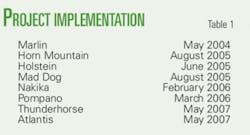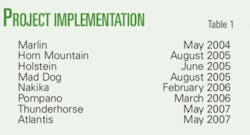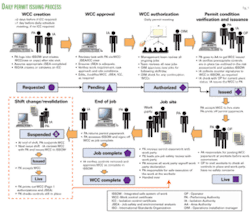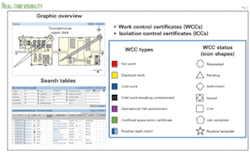To ensure consistency in application across all its deepwater Gulf of Mexico assets, BP has worked with Petrotechnics to identify and implement industry best practices and incorporate those into a uniform approach to how all work is done at the frontline. A key element in achieving these results and providing for sustainability and continuing improvement is the Petrotechnics’ electronic permit-to-work (eptw) system called Sentinel PRO.
This is an internet-based software system that leads people through a carefully designed process for safe-work execution. The process ensures that all executed work is assessed rigorously in terms of hazards and risks, planned properly with controls for all identified hazards and risks, and executed in a safe manner in coordination with all other work being conducted.
Offshore operations
A statement of the obvious: offshore oil and gas production is a challenging business. The facilities and equipment needed for deepwater production are complex and require constant attention. These facilities handle large quantities of hydrocarbons, and the potential consequences of a mishap can be serious. On these complex facilities, the execution of multiple, simultaneous tasks is required on a 24/7 basis to operate, maintain, repair, and improve the facilities and equipment necessary to produce oil and gas.
Conscientiously managing and controlling all these tasks are essential for increasing operational safety, effectiveness, and efficiency. Working safely always has been a primary concern of companies operating offshore facilities, but new technology is now being employed more aggressively to support people in working safe and working smart.
More and more offshore oil and gas facilities in the Gulf of Mexico are taking safe-work practices further. Oil producing facilities in the Gulf of Mexico operated by both Shell and BP now use a software-supported process to ensure that every task undertaken in this hazardous process work environment is planned thoroughly and executed in a safety first manner.
During a 12-month period beginning in September 2007, eight BP offshore facilities in the Gulf of Mexico have worked closely together to improve, standardize, and harmonize BP’s control of work systems, processes, and practices (Table 1). The effort included the work with Petrotechnics mentioned previously.
BP Gulf of Mexico Deepwater Production was one of the early adopters of the Sentinel PRO electronic permit-to-work system in the gulf and realized good results in terms of integrating its safe-work systems (Fig. 1).
The operational leaders and health, safety, and environmental (HSE) professionals in this BP strategic performance unit believe in the value of the real-time visibility of the location, type, and status of work operations that is possible with the Sentinel PRO system (Fig. 2).
When Thunderhorse and Atlantis platforms came online in the gulf, BP was committed to implementing the same control of work systems on those platforms right from the beginning. In planning the implementation of integrated safe-work processes, BP also upgraded to the newest version of the Sentinel PRO eptw system across all of its deepwater facilities.
null
Harmonizing systems
When the implementation team started thinking through this effort on employing the new software version, it realized that this endeavor provided an opportunity to harmonize not only the permit-to-work system, but also all other safe-work systems used across all offshore facilities.
The team realized that even though all facilities used the same electronic permit-to-work system, there were some notable differences in other safety practices, such as “lock-out-tag-out” and some task risk assessment procedures. This was an opportunity to look at best practices across all assets and get everyone to standardize on a uniform set of best safety practices and procedures.
Of course, the facilities have some differences. Some are small and some are very large. There are different operations being conducted on each one and there are significant differences in some of the equipment on the different platforms. There were reasons, therefore, for different operational processes but not for different control of work procedures.
The implementation team knew that the apparent differences and normal human aversion to change would result in some understandable resistance to change when people anticipated having to adopt something different from what they were doing.
With some facilitation assistance and additional information about best practices from the Petrotechnics team, BP assembled representatives from all Gulf of Mexico facilities in one room and moved forward with the task. The people were carefully selected so that they represented a variety of levels and disciplines within the Gulf of Mexico organization.
Represented were people from most of the different crafts involved in the maintenance, repair, and other work done on production platforms. This group chose the team name HEAT (harmonization essentials action team).
After some initial disagreements, the team identified and integrated major elements required for harmonization. These included but were not limited to:
- Hazard identification.
- Risk assessment.
- Lockout tag out (LOTO).
- Safe isolation and return to process.
- Management of change.
- Safety awareness.
- Safe practices manual.
Through the process, everyone came to understand that each was committed to safe-work execution and wanted to identify and adopt the “best of the best” in terms of safe-work practices.
In hindsight, proper attention to the membership and work of the HEAT team was a key for success. The HEAT team members proved to be some of the best ambassadors for implementing the Sentinel PRO system upgrade in a rigorous and disciplined manner. Their advocacy and support during the harmonization and implementation process did much to reduce resistance to change and facilitate rapid acceptance of the new system.
Everyone saw the advantages and efficiencies of having one set of the best possible safe-work practices in place uniformly across all platforms. The Sentinel PRO eptw system provided a vehicle for ensuring, and reinforcing–every day, task by task–that every single task was reviewed, planned, evaluated, authorized, approved, executed, and closed out in accordance with a single set of safe-work standards and procedures.
When the HEAT kickoff meeting was held in September 2007, the team took on the challenge of harmonization in order to:
- Leverage current best practices.
- Achieve the greatest possible harmonization and uniformity across all Gulf of Mexico assets.
- Support the BP worldwide control of work standard.
- Move toward industry best practices.
- Establish a base line and a process for continuing improvement.
Harmonization has several other advantages in terms of BP people moving from one platform to another and experiencing consistent practices at all facilities. It also helps the contractors who work on several different deepwater facilities because there is now much more uniformity in the way all facilities ensure that work is conducted safely. The effort has reduced the need to learn multiple different processes.
Parallel and linked to the work of the HEAT team, Petrotechnics configured its Sentinel PRO software in accordance with the harmonized processes and practices. Once all of the harmonization work was completed, it was time to install the upgraded Sentinel PRO software on each platform and to provide training for all who would use the new electronic permit-to-work system and the new harmonized set of safe-work systems.
Software features
The Petrotechnics integrated safe system of work solution, Sentinel PRO, is more than an electronic replacement for a paper-based permit-to-work system. It pulls together a number of safe-work practices and procedures into a single integrated system designed to streamline, standardize, and control the work process. Key safety features include:
- Provides a real-time graphical interface that displays the location and lifecycle status of all work permits on a layout of the facility.
- Allows users to see work conflicts, type of work, and progress at a glance.
- Integrates permit to work, risk assessment, and isolation management.
- Manages approvals via electronic signatures.
- Provides database of past permits, risk assessments, lessons learned, etc. to facilitate and improves the creation and review of new permits, especially in the case of repetitive and frequently executed tasks.
- Contains built-in audit and other monitoring features with electronic questionnaires.
Implementation, training
Coordinating the hardware, software, training, and other elements of this major undertaking had a few hiccups. Having two knowledgeable persons on the ground was essential. K.P. Rosamond from BP and Trent Pearson from Petrotechnics made sure that everything was scheduled and executed. They also worked closely together to ensure that all issues were raised, addressed, and hammered out so that the system quickly worked well for all BP deepwater facilities.
During this cooperation, more than 500 people were trained in the use of the new Sentinel PRO web-based safe work system. Training sessions were kept relatively small to ensure effective knowledge transfer. The endeavor involved more than 45 training sessions, conducted mostly at BP’s Houma, La., offices Also, several additional coaching sessions were held on the various offshore facilities to provide in depth, hands-on experience with the features and functionality of the new safe-work system.
Now every single permit to work on each BP offshore facility is handled in the same way 24/7/365. The Sentinel PRO safe-work system ensures that the same set of safe-work practices (risk assessment, LOTO, safe isolation, etc.) is applied in a uniform manner.
Continuing attention by HSE and operations leaders reinforces the link between these safe-work systems and the BP overall control of work approach.
The experience of undertaking this effort to harmonize all safe-work systems across all Gulf of Mexico facilities and implementing a single system of permitting work based on a uniform set of standards, policies, and procedures has been instructive. In retrospect, some of the anticipated resistance did happen, but high-quality training and coaching did much to minimize the difficulties of the changes.
Observed benefits
Now that the platforms all use a uniform approach and people have had a little time to work with this new system, the following are some of benefits noted:
- Safety audits are more meaningful, and audit results have greater and wider applicability.
- BP’s deepwater production facilities share more knowledge. The fact that all facilities have the same basic system makes lessons learned more applicable to everyone.
- HSE professionals have a greater and more meaningful community of interest.
- Higher levels of leadership are becoming more interested in safe-work execution at the facility level and are finding ways to use the internet connectivity to the various facility eptw systems to check on things such as the quality of risk assessment, isolation controls, etc.
- There is a higher level of concern about a more thorough integration of safe-work processes and practices. And, there is more energy to resolve potential issues with the application of BP’s global control of work standard.
The BP Gulf of Mexico deepwater facilities have improved safety through better process rigor and transparency from clear lines of authorization and ownership of work. With this new internet-based system, it is now possible to monitor, review, and audit how people use these safe-work systems from anywhere on the globe with access to the internet.
Some specific results realized are:
- The endeavor has eliminated 10-15% of permit to work related rework and preplanning, thus freeing up time and allowing personnel to work more efficiently.
- The harmonization of operational working practices has produced benefits in terms of safety, effectiveness, and cost savings.
- A single, uniform approach and a standard electronic permit-to-work system across all Gulf of Mexico facilities have made it much easier for BP to ensure that all new people and contractors are properly trained before they arrive on the platforms–thus making time offshore more productive and profitable.
Individuals closest to the design and execution of the harmonization effort and greater integration of safe-work systems are positive about short-term results, sustainability, and greater long-term benefits. The specific results listed previously are all positive contributions to a work environment in which safety and performance go hand-in-hand and both continue to improve.
The integration of the Sentinel PRO eptw system with the other safe-work systems is a central and reinforcing force that encourages continuing viability and sustainability of the overall integrated safe system of work. The increased rigor applied to, greater access to, and visibility of, the work associated with hazard identification, task risk assessment, isolation controls, etc. is involving more people who are beginning to be even more creative in finding potential improvements in safe-work systems.
The authors
Allen Saville is vice-president of consulting with Petrotechnics USA Inc., Houston. He has 30 years of consulting experience in the areas of strategic planning, performance improvement, organizational design and development, executive and leadership development, and change management. Saville has a degree in law from the University of Virginia and Masters and Doctoral degrees emphasizing planning and management systems from Virginia Tech.
Stan Garner is HSSE manager for BP Gulf Of Mexico Production Operations. Garner has worked in the health, safety, and environmental (HSE) profession for more than 28 years within the upstream oil and gas industry. He started his career with Amoco. Garner has a BS and an MS in Industrial Safety from the University of Central Missouri, as well as an MBA from the University of Colorado.
K.P. Rosamond is the control of work technical authority for BP’s Gulf of Mexico SPU. He has 10 years of experience in HSE built around operations and projects. Rosamond dedicates much of his time to developing HSE action plans by means of cross-communication between field representation and BP management.








